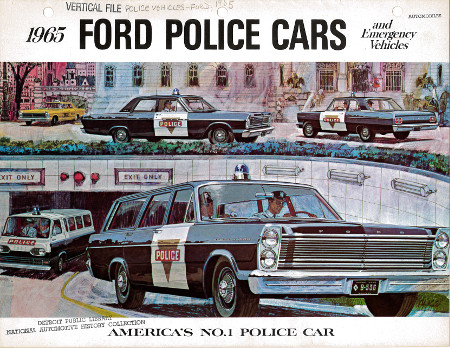By Robert Tate, Automotive Historian and Researcher
Images courtesy of the National Automotive History Collection
Posted: 10.17.2016

Our history of law enforcement vehicles includes a variety of models used in a variety of ways to patrol and protect the motoring traffic from speeders and other traffic violators.
The history of the law enforcement vehicle started many years ago during the 1800s. In the beginning, law enforcement used horses and patrol wagons for police work. By the 1920s, the automobile had provided great service for the police and on a historical note, the automobile was one of the major reasons the state police came into existence.
As automobile design changed over the years and new roads were constructed, many Americans could travel farther and more often. With more traffic on the burgeoning roadway system, additional laws were needed to promote safety for the motoring public.

This story is about the post-war years of law enforcement vehicles. During World War II, the availability of automobiles was not used because of the war-time efforts that were taking place in our country. New automobiles were not available from 1943 through 1945.
After the war had ended, law enforcement agencies focused on Ford or Chevrolet models because of lower prices and their high-performance engines. For example in 1947, many law enforcement agencies used the popular Deluxe Tudor Ford model which was the base car for many fleet and police special units.
In 1956, Ford again became very popular with many law enforcement agencies. The brochure advertising the new models stated “Preferred by Law Enforcement Agencies everywhere.” That same year, Ford offered the Custom line the Mainline and Country sedan wagons. The models were available with the new 215-h.p interceptor V-8 engine that was very fast. It offered new power and long lasting durability for law enforcement activity.

Chevrolet models were also popular with police during that time period. The 1961 Chevy models, for example, were used by many policemen who thoroughly enjoyed their performances.
The models were available with a Turbo-Fire V8 engine that was new and offered great durability and performance when handling crime. The 1961 Chevrolet models were available in the Biscayne series along with the popular Brook Wood 4-door and 6-passenger station wagon model as well. The models also offered a complete Chevrolet accessory group for many police enforcement needs.
In 1965, again Ford was considered the number-one for police cruisers, however Chrysler also had become very strong in the fleet sales for law enforcement agencies.

I remember as a young kid in 1965, and watching a Detroit police department taking delivery of many new 1965 Plymouth patrol models. They were called the Tactical Mobile Unit which was a special squad for instant emergency action.
Other models included the Fury Pursuit models that were fitted with a 330-horsepower Commando 383 engine; the models were available in a 2-door and 4-door sedan. The 1965 Plymouth Pat roller was a specialized model built with a 6-cylinder, 145-horsepower engine. All Police Specials were factory-built with varying equipment to fit them for their special kinds of police work.
Chrysler during the 1960s continued to demonstrate its great performances for law enforcement agencies with Dodge. Dodge had provided many years of great service for law enforcement agencies with their popular 1950s and early 1960 models. For example, the 1961 Dodge Dart Seneca was an ideal car for police work. The models offered six police pursuit engines ranging from 230, 318 V-8 to the 325 horsepower Special Police pursuit models.

From 1971-1973, the Dodge Polara Police Pursuit models were offered for law enforcement agencies along with the popular Dodge Coronet and the B-model Tradesman van.
In conclusion, police vehicles from the past have a strong following today among hobbyists and are very collectible if you can find them.

A special thanks to Robert Tate, Automotive Historian and Researcher, for contributing this story to the MotorCities Story of the Week Program.
For further information on photos please visit http://www.detroitpubliclibrary.org/ or email This email address is being protected from spambots. You need JavaScript enabled to view it.. Please do not republish the story and/or photographs without permission of MotorCities National Heritage Area. (Bibliography: Dammann H., George: “Illustrated History of Ford” Crestline Publishing 1970; McCord Monty: “Police Cars: A Photographic History” 1991; McCord, Monty. “Cars of the State Police and Highway Patrol” 1994. )



